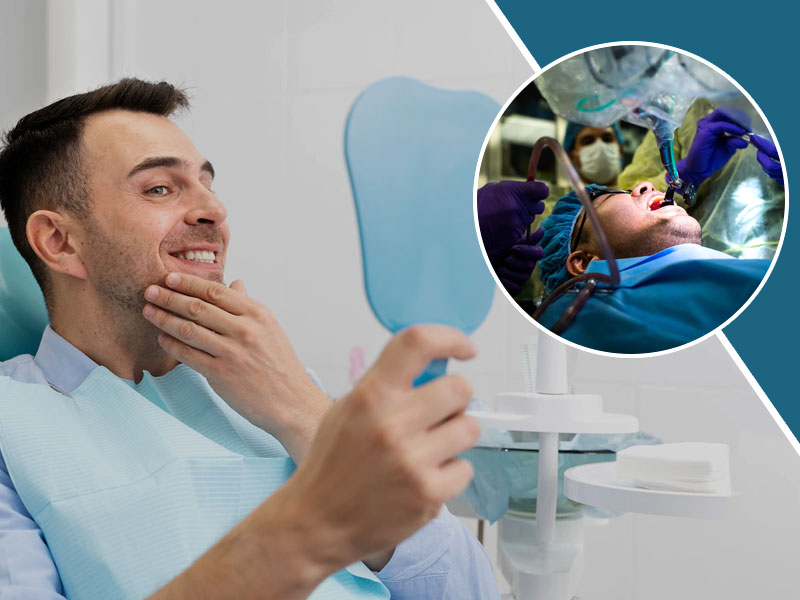
Dental implants have been the primary procedure for replacing teeth in recent years. The success of implants, on the other hand, is dependent on the accuracy with which they are placed to support prosthetic restorations. Implant dentistry science has come a long way in terms of assuring the precise placement of dental implants, thanks to the development of static surgical guides. Yomi is the world's first and only FDA-cleared robot-assisted dental surgery system. It might act as an assistant to the clinicians in both the planning as well as the surgical phases of dental implant surgery. Know more about yomi robot and its significance in robotic dental implants from Dr. Rajesh Shetty, Clinical Director, and M.D.S, Periodontist and Implantologist.
Table of Content:-
The best way to explain this is, that it is like a Tesla car. It doesn't have the capability of doing the entire work but it gives the necessary feedback. For example, if you drive a Tesla car and suddenly a car before you stop, your car does not automatically stop, but it gives out a warning of the possible danger. That is exactly how the robot will be working for a human. In many circumstances, this will allow surgeons to insert implants without the need for a knife or sutures.
Also Read: Dental Treatment During Pandemic Is Safe If You Follow These Instructions
Yomi Haptic Guidance
Yomi has enabled doctors to provide high-quality care with unrivalled accuracy and precision. Here is how it helps in dental implant surgery:
- Yomi robot sends a tangible signal to the dental surgeon's hand, guiding it to the correct angulation and placement for the intended osteotomy.
- Yomi firmly maintains the handpiece trajectory after it is in place, preventing unintentional departure from the desired plan.
- Yomi also follows and monitors the patient with extreme precision if the patient moves.
- Yomi gives the dental surgeon the assurance of a physical "hard stop" when the drill bit reaches the desired depth.
- At each stage of the dental procedure, distinct auditory signals are supplied. The graphic display on the Yomi monitor may also provide visual confirmation and quantitative data to the dental surgeon.

If Yomi proves to be beneficial to you, your dental team will devise a personalised dental treatment strategy for you. The Yomi software may be used to make this unique plan available. Yomi will aid your surgeon during surgery and offer vital information that your surgeon can feel, hear, and see. Yomi will work with your surgeon to ensure that your implant is placed according to the exact plan.
How is yomi helpful for dental implants?
Yomi uses haptic robotic technology and multisensory input to offer adequate direction to dental surgeons, assisting them in achieving the precise angulation, position, and depth to effectively place the implant in line with the design. Yomi's real-time visual guiding and robotic haptic guidance also allow for a minimally intrusive approach, which can result in a speedier operation, quicker recovery, and less discomfort for the patient.
Also Read: Are Technology-Based Interventions For Weight Loss Safe and Effective? Find Out
Benefits of Robotic dental implants

Here are some reasons why you should choose yomi robotic dental implant:
Improved recuperation time
With this technology, your doctor can plan every stage of your surgery. This means the implant is placed in the exact spot using a minimally invasive approach rather than the typical method of making an incision in your gum and peeling back a flap of tissue to place your implant below.
Reduced chance of mistakes
Placing dental implants free-hand is an age-old and established approach. The doctor performs free-hand surgery with portable equipment and printed or machined surgical guidelines to illustrate where the implant should be placed.
- The surgical guide prevents the physician from altering the surgical plan during the process, perhaps causing delays.
- When operating in tough-to-reach places, certain surgical guides don't fit well and make things harder.
- Physical guides like Yomi, on the other hand, provide for a less intrusive approach to a completely individualised surgical experience.
Also Read: Here's Everything You Need To Know About Dental Implants

Image Credits- Assets Advanced Dentistry
Treatment efficiency
Yomi's digital process allows your treatment to be finished in fewer visits in some situations, which can save you time and money.
Assume a patient walks in. They arrived with damaged teeth, for example, and require an implant. Because there is no need to send for a guide, the surgeon may quickly remove it and install the implant right away. As a result, this is unquestionably the future of dentistry. In dentistry, this is the initial step toward robots.
Will it replace surgeons?
The surgeon controls the dental handpiece at all times, but robotics technology provides real-time input via haptic technology to help them through the treatment plan. The technology is designed to supplement rather than replace a surgeon's clinical skills. As a result, it will not replace surgeons, but rather will assist them in providing the best treatment plan for the patient.
"I'm continuously searching for better technologies, new methods to improve," Dr Rajesh Shetty concludes, "but one of the most important things to me is that if I'm going to accept a new technology or new technique, I have to make sure it's going to be beneficial for the patient."
Image credits- freepik
Also watch this video
Read Next
6 Tips To Recover From Migraine Pain
How we keep this article up to date:
We work with experts and keep a close eye on the latest in health and wellness. Whenever there is a new research or helpful information, we update our articles with accurate and useful advice.
Current Version